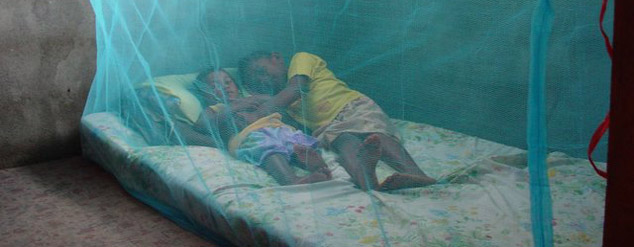interviews & profiles
Fighting Malaria with Bednets
Jan 05, 2007

RailRiders spoke with Jamison in December 2006. \"The RailRiders clothing was fantastic, truly,\" he told us. \"I\'m not a fan of the heat, and the vents and lightweight kept me cool. This was especially important since I wore long sleeves and long pants, partly for appropriateness and partly for sun protection. My main choices, worn for days on end, were Eco-Mesh Pants and Eco-Mesh Shirts, though I also had Adventure Pants and an Oasis Shirt with me. My colleagues were impressed, especially with the Eco-Mesh Pants leg zippers. They wanted to know where they too could find such neat and useful togs.\"
Jamison and his research team are still analyzing the data collected from their malaria bednets study. Our interview with the social scientist follows, but first a few words about malaria which looms as a major public-health problem in the Third World. The disease infects around 400 million people every year and causes between one and three million deaths annually. It\'s especially prevalent in tropical and subtropical regions.
The disease is caused by protozoan parasites which are transmitted by female Anopheles mosquitoes after biting an infected person. The parasites multiply within red blood cells, causing symptoms that include symptoms of anemia, fever, chills, flu-like illness, and in severe cases, coma and death.
Unfortunately, no vaccine is currently available for malaria. Malaria infections are treated through the use of antimalarial drugs, such as chloroquine or pyrimethamine, although drug resistance is increasingly common. Several drugs like mefloquine-- its brand name is Lariam--can be taken preventively, but usually only for a short period and then there can often be unpleasant side-effects.
Malaria\'s transmission can be effectively reduced via spraying insecticides inside houses and draining standing water where mosquitoes lay their eggs. At one time, DDT was used extensively until it was discovered that it caused too many health risks to humans.
Because female mosquitoes feed at night, insecticide-treated bednets are effective in helping to keep mosquitoes away from people, and thus greatly reduce the infection and transmission of malaria. Both the United Nations and the World Health Organization have programs which distribute bednets for as little as several dollars each. That doesn\'t seem like a lot of money, but for those eking out an existence in grinding poverty, these nets aren\'t always affordable, especially for those most at risk. For example, only one out of 20 people in Africa own a bednet.
Q: Why, as an economist, did you decide to study the use of mosquito bednets in Vanuatu? What is it about the island nation that attracted you?
Julian Jamison: I studied mathematics in college and switched to theoretical economics in graduate school. My focus has been the modeling of human behavior and in particular how we make decisions, especially those related to risk, uncertainty, and time. Although I like to say that I work with beautiful models and formal abstractions, I have been doing more and more applied empirical work. It quickly became apparent that health behaviors were both vitally important and conceptually fascinating, so I joined a team asking such questions as, \"Why do individuals choose to use or not use bednets? Should we be trying to alter that behavior, and if so how?\"
Malaria is a concern for much of the world\'s population, so it was a natural disease to focus on. As for Vanuatu, to be honest it was in part because of the exotic appeal; James Michener based his island of Bali Hai from South Pacific on one of the Vanuatu islands. I love to travel and have been to almost 50 countries for work and pleasure. But there are also excellent scientific reasons in this case: the ultimate goal is to eradicate malaria, and it makes sense to start that process at the boundary of the world\'s endemic malarial zones, such as Vanuatu, rather than in Africa where the burden is unfortunately that much greater.
Q: Who provided the bednets? And how are they made?
JJ: The bednets were provided by the Global Fund to Fight AIDS, Tuberculosis, and Malaria. They are Olyset long-lasting nets (LLNs), in which the insecticide (permethrin) is woven directly into the polyethylene fiber. This means that they remain potent against mosquitoes for three to five years, which is much more effective than requiring inconvenient retreatment every six months as was previously the case.
Q: Are you connected with the Bill and Melinda Gates Foundation?
JJ: The Gates Foundation is funding a large community-based evaluation on the scaling up of malaria control activities in Vanuatu, and my work is supported through that effort.
Q: What were your hypotheses before the study? And what do you hope to find out when your study is completed?
JJ: One common hypothesis is that individuals who know more about malaria will be less likely to be infected themselves, more likely to use bednets, and willing to pay more for new and better nets. However, we wanted to additionally explore whether or not the same people who were disease-free (and/or used bednets) were also more risk-averse in other domains of life. It turns out that experimental economics offers a useful toolbox for approaching these types of questions. If there is such a relationship, it will give us a whole new way to target interventions toward the most vulnerable individuals.
Q: What are the major differences between an epidemiological study and an economic study?
JJ: I\'m really only qualified to discuss the latter, but my sense is that epidemiologists tend to be concerned with describing what is happening and a little bit less with why it\'s happening. Economists are social scientists who are interested in humans and social systems and governments. We ask what incentives (not necessarily monetary) are at work, and what would happen if those changed. For example, an epidemiologist might be able to tell you how quickly malaria will be transmitted by a certain density of mosquitos (which is extremely valuable information), while an economist might be able to tell you whether better information or cheaper bednets is more likely to cause people to respond to such an influx of the disease.
Q: How did the villagers in Vanuatu respond to the study? And how did you approach them? What were the language and cultural barriers? And how were these addressed?
JJ: For the most part the villagers were very receptive to our work. We had a long survey that we used to interview one member of each household, and then we took fingerpricks to draw blood from each member ( ranging from infants to great-grandparents) to test for malaria. So it was quite a process, but we had the support of the local government, and we always first approached the village chief to explain what we were doing and how it would help both his people and others worldwide. A few of the more traditional (kastom) villages took more convincing, but everyone came around in the end.
The Ni-Vanuatu (people of Vanuatu) learn either French or English in school, so my high-school French came in handy. But the true lingua franca of the archipelago is Bislama, a creole English originally developed by traders. There is an amazing diversity of local languages, sometimes completely distinct just a few villages apart. But almost everyone speaks Bislama, so we translated our survey into it and had several wonderful multilingual Ni-Vans on our team to conduct the interviews and interpret for us if necessary.
Q: What was the villagers reception to the bednets? How is it impacted by schooling, cultural bias, poverty, alcohol use, etc?
JJ: On the whole, they were quite open to the idea of bednets and especially interested in the newer versions. Most households had bednets, though many of them were old and somewhat ragged, and they weren\'t always used regularly. Or if they were, they were used occasionally as fishing nets. I couldn\'t help noticing that some families had spent a relatively large fraction of their disposable income to buy bednets. As for which factors affect usage the most, you\'ll have to ask me again in a few months when we\'re done with the analysis! I should add that alcohol is quite rare (and expensive when it can be found) in the villages; instead they enjoy coconut shells filled with kava, the only legal narcotic in the world.
Q: How long will the study last?
JJ: The study is on-going, but the initial work constituted about six months of fieldwork, spread out over the dry season (when I was there) and the rainy season (when the mosquitos and malaria are worse). That way we got a sense for the prevalence of the disease in both environments; somewhat incredibly, before this no one actually knew precisely how much malaria there was, since the laboratory tests are too expensive and time-consuming to use on a regular basis in the remote parts of Vanuatu.
Q: Who was part of your team?
JJ: The project is led by Carol Medlin at the University of California at San Francisco. We worked in collaboration with George Taleo at the Vanuatu Ministry of Health and Corinne Capuano of the World Health Organization. Zach Isdahl (also from UCSF) was in charge of our wonderful field team.
Q: How does malaria rank worldwide as a sickness, say compared with AIDS, hepatitis, or tuberculosis?
JJ: In terms of total deaths, malaria ranks somewhat behind AIDS or tuberculosis (though ahead of hepatitis or, say, breast cancer). What is distinctive about it is that it kills mostly young children, including over a million per year under age 5. This is far more than AIDS or TB within that population, so malaria is truly a disease of the dispossessed: young, poor Africans. This is not a group with a strong political voice, so it is especially vital to make sure that they are not left behind.
Q: What was the most difficult part of your study? And describe the living conditions for you and your team?
JJ: Some of the team got a bit tired of our diet: taro, taro, and more taro. It\'s a tuber sort of between a potato and a yam but larger. However I liked it a lot. On the other hand, I\'m not a hot weather person, so the heat and humidity weren\'t at the top of my list. Of course there was no running water or electricity in the villages, and no paved roads, including runways for the island-hopping planes but I\'m used to that from mountaineering and generally had a great time.
Q: Have you ever gotten malaria? Dengue fever?
JJ: No, I\'ve been quite lucky in my travels -- just the occasional food poisoning or bad flu. Malaria is actually more dangerous in some ways for visitors than for local adults who are otherwise healthy, since any of them who survive to adulthood have usually had malaria several times already. I take anti-malarials when I travel to active malaria zones, and I try to use bug spray and a bednet. Embarassingly, I didn\'t use one every night in Vanuatu, since it was the dry season, but I was taking my drugs regularly, and it was so hot. I tried not to let anyone see my lax behavior!
Q: What most surprised you during your fieldwork there?
JJ: It was the enthusiasm and curiosity on display almost everywhere we went. People wanted to know about the project, and about where we were from, and what we thought of their island. We had digital cameras with us, and seeing the schoolkids scream aloud when they saw themselves on the viewer was simply electric.

